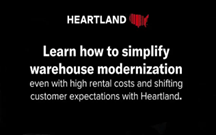
5 Benefits to Paperless Warehousing
Mar 14, 2024
Do you want to reduce costs, save space, and limit the environmental impact of your operations? Go paperless. Years ago, countless businesses in distribution and retail were utilizing paper-based systems. However, in today’s world, many businesses have opted to cutting down their inefficiencies, waste, and redundancies by switching to warehouse automation—such as scanning technology and other paperless warehouse management systems. While paper-based systems are a thing of the past for some, there are still a great number of companies that are meandering through paper-based processes. Of course, the initial cost of switching from a paper-based system can be overwhelming, but that change can produce several long-term benefits. At Heartland, the future’s already here—with automated solutions that encourage total modernization, regardless of industry. With our scalable and sustainable solutions, you—and the environment, too—will benefit greatly, in ways like:
- Improved Warehouse Efficiency and Visibility – Of course, staying on top of every single order and shipment is far from being an easy task. Alterations happen almost every minute on the warehouse floor and, if your business is still tracking orders and shipments by hand, you could be recording data inefficiently and inaccurately. Warehouse management systems (WMS) possess several reporting abilities for each task within the warehouse, where information is provided instantaneously. In a paper-based warehouse, however, there is only one method for tracking performance and productivity—pen-and-paper logging, which is not only tedious but can also produce mistakes as the logs are as good as the information that each employee enters. Switching to paperless systems will enhance visibility in the warehouse and guarantee that the information is always accurate and up to date. In implementing mobile device within your warehouse, its accuracy will increase to nearly 100%.
Related: How to Protect Assets from Incomplete Visibility
- Increased Productivity – Maintaining a paper-based warehouse system requires great amounts of time and resources. Not only that, but—once you consider the money and time it takes to maintain printers, material costs, and organize paperwork—it’s clear to see that time could be spent more efficiently. Thankfully, with Heartland’s distribution solutions, implementing a modernized, paperless warehouse management system (WMS) has never been so seamless. In doing so, your business could decrease or entirely get rid of the costs associated with paper-based systems—increasing levels of productivity, too. Integrating a paperless system into your business will ensure that the margin for mistakes is small, while any concerns that do transpire can be fixed nearly instantaneously. Immediate access to seamlessly manageable information will enable your employees to input highly accurate data entries and experience less delays in gathering information.
Related: 4 Questions You Need to Ask Your Warehouse Management System
- Better Customer Service and Flow of Goods – Another vital benefit of paperless warehouse management systems is having the capability to manage a diverse flow of goods to and from multiple warehouse locations. Oftentimes, it is challenging for any management team to keep track of the location, destination, and shipping status of every product on hand. Similarly, paper-based systems can have situations where the inventory that is on the books and the physical inventory in the warehouse do not match, creating chaos and potential poor purchasing processes. When the flow of goods is not effectively maintained, customer service can also face detrimental effects. For example, if a customer purchases a product that is not actually in stock, longer wait times for them can transpire—leading to substandard customer satisfaction. To avoid this, switching to a paperless warehouse management system will allow you to accurately and efficiently track the flow goods going in and out of your warehouse—guaranteeing that inventory levels are tracked and recorded with precision, every time.
Related: Why Managing a Warehouse with RFID Tracking is Easier
- Save Space – A fully modernized warehouse management system can track every location and knows where each product and received quantity should be stored in the warehouse. Such warehouse management systems can inform the worker of how to properly utilize space in real-time. On the other hand, manual putaway processes solely rely on the worker to acquire the proper location for a product. If workers are manually storing items, products will often be stored in locations that are most convenient to them, rather than the most appropriate location that efficiently suits the size of the product. In addition to that, not every location can be physically visible to a putaway worker, which could lead to empty shelves and other storage areas.

Related: 4 Ways to Improve Warehouse Space Utilization - Reduce Costs and Environmental Impact – Keeping paper in a warehousing environment requires a great number of resources. The prices of printer ink, paper, and maintenance can cost you thousands and the environment significantly as well. By going paperless, you not only save your business time and money while improving efficiency, but you also do the environment a great favor in vastly diminishing the amount of used paper. According to studies conducted by The World Counts, the yearly production of cardboard and paper around the world is 420 million tons—which equates to two pieces of paper for everyone on the planet every hour. By removing pen-and-paper methods from your procedures, you will cut back on costs of operations, improve accuracy, and enhance warehouse space. To put it into perspective, according to the Environmental Protection Agency (EPA), an average employee will use 10,000 pieces of paper each year. In that, when multiplying the complete number of pieces of paper by the average price of paper, it is clear to see that this employee indirectly spends about $1,000 on paper alone. Of course, implementing sustainability procedures throughout your operations will make you feel good. As of late, many businesses have begun to recognize the environmental benefits of digitizing wherever possible. To a few, the significance of a paperless warehouse is not solely about the workflow and business benefits, but also about being bothered by the state of the environment and wanting to reduce waste and consumption as much as possible. Converting to a paperless warehouse, of course, will not entirely rid your processes of paper, however; progressing your business’ records from paper documents to the digital world can make administrative tasks much more seamless and efficient. Utilizing Heartland’s scalable and sustainable solutions will provide you second-to-none ROIs. Applying modernization processes into your business will enlighten you to the big improvements that will come down the line when small changes are made now.
Related: How Modernization Strategies Adapt to Rising Operational Costs
At Heartland, we take great pride assisting businesses in obtaining maximized warehouse optimization through our scalable, sustainable, and effective solutions. Today, there is no need to pick between optimization and sustainability—because, at Heartland, we work with both. If you’re interested in reaching a new level of warehouse optimization and sustainability, reach out to us today.






